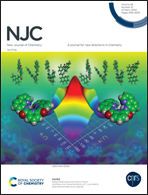Trifluoromethyl-pyridine carboxylic acid Zn(ii) complexes: isomeric effects on coordination and biological activity†
Abstract
Isomeric ligands usually affect the structure and biological activity of complexes. Two Complexes [Zn(tpc)2(H2O)2](1) and [Zn(tfc)2(H2O)2](2) were synthesized with isomeric ligands (Htpc = 5-(trifluoromethyl) pyridine-2-carboxylic acid, Htfc = 4-(trifluoromethyl) nicotinic acid). Single crystal X-ray studies revealed the structural differences between the two complexes, where the coordination mode of complex 1 is N, O chelated coordination and that of complex 2 is N, O monodentate coordination. Due to the structural variations between the two complexes, the binding activity of two complexes with bovine serum albumin (BSA) or calf thymus DNA (CT-DNA) changed. Both complexes can quench BSA statically with binding constants of 105–106 L mol−1. Thermodynamic studies showed that the binding processes are spontaneous (ΔG < 0) and hydrogen bonding and van der Waals force play an important role in the binding processes (ΔH < 0, ΔS < 0). Complexes bind to CT-DNA through the intercalation mode, which was further verified by ethidium bromide (EB) competition experiments. Compared with complex 2, complex 1 with N, O chelated five-membered ring showed higher binding efficacy toward these biomolecules. It is speculated that the N, O chelating structure increases the binding properties of the complexes with biological macromolecules.



 Please wait while we load your content...
Please wait while we load your content...